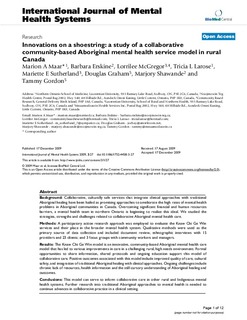| dc.contributor.author | Maar, Marion A | |
| dc.contributor.author | Erskine, Barbara | |
| dc.contributor.author | McGregor, Lorrilee | |
| dc.contributor.author | Larose, Tricia L | |
| dc.contributor.author | Sutherland, Mariette E | |
| dc.contributor.author | Graham, Douglas | |
| dc.contributor.author | Shawande, Marjory | |
| dc.contributor.author | Gordon, Tammy | |
| dc.date.accessioned | 2019-09-09T05:47:23Z | |
| dc.date.available | 2019-09-09T05:47:23Z | |
| dc.date.created | 2016-07-07T09:51:37Z | |
| dc.date.issued | 2009 | |
| dc.identifier.citation | International Journal of Mental Health Systems. 2009, 3 (27), . | nb_NO |
| dc.identifier.issn | 1752-4458 | |
| dc.identifier.uri | http://hdl.handle.net/11250/2613829 | |
| dc.description.abstract | Background
Collaborative, culturally safe services that integrate clinical approaches with traditional Aboriginal healing have been hailed as promising approaches to ameliorate the high rates of mental health problems in Aboriginal communities in Canada. Overcoming significant financial and human resources barriers, a mental health team in northern Ontario is beginning to realize this ideal. We studied the strategies, strengths and challenges related to collaborative Aboriginal mental health care.
Methods
A participatory action research approach was employed to evaluate the Knaw Chi Ge Win services and their place in the broader mental health system. Qualitative methods were used as the primary source of data collection and included document review, ethnographic interviews with 15 providers and 23 clients; and 3 focus groups with community workers and managers.
Results
The Knaw Chi Ge Win model is an innovative, community-based Aboriginal mental health care model that has led to various improvements in care in a challenging rural, high needs environment. Formal opportunities to share information, shared protocols and ongoing education support this model of collaborative care. Positive outcomes associated with this model include improved quality of care, cultural safety, and integration of traditional Aboriginal healing with clinical approaches. Ongoing challenges include chronic lack of resources, health information and the still cursory understanding of Aboriginal healing and outcomes.
Conclusions
This model can serve to inform collaborative care in other rural and Indigenous mental health systems. Further research into traditional Aboriginal approaches to mental health is needed to continue advances in collaborative practice in a clinical setting. | nb_NO |
| dc.language.iso | eng | nb_NO |
| dc.publisher | BMC (part of Springer Nature) | nb_NO |
| dc.rights | Navngivelse 4.0 Internasjonal | * |
| dc.rights.uri | http://creativecommons.org/licenses/by/4.0/deed.no | * |
| dc.title | Innovations on a shoestring: a study of a collaborative community-based Aboriginal mental health service model in rural Canada | nb_NO |
| dc.type | Journal article | nb_NO |
| dc.type | Peer reviewed | nb_NO |
| dc.description.version | publishedVersion | nb_NO |
| dc.source.pagenumber | 12 | nb_NO |
| dc.source.volume | 3 | nb_NO |
| dc.source.journal | International Journal of Mental Health Systems | nb_NO |
| dc.source.issue | 27 | nb_NO |
| dc.identifier.doi | 10.1186/1752-4458-3-27 | |
| dc.identifier.cristin | 1366690 | |
| dc.description.localcode | © 2009 Maar et al; licensee BioMed Central Ltd. This is an Open Access article distributed under the terms of the Creative Commons Attribution License (http://creativecommons.org/licenses/by/2.0) | nb_NO |
| cristin.unitcode | 194,65,20,0 | |
| cristin.unitname | Institutt for samfunnsmedisin og sykepleie | |
| cristin.ispublished | true | |
| cristin.fulltext | original | |
| cristin.qualitycode | 1 | |

